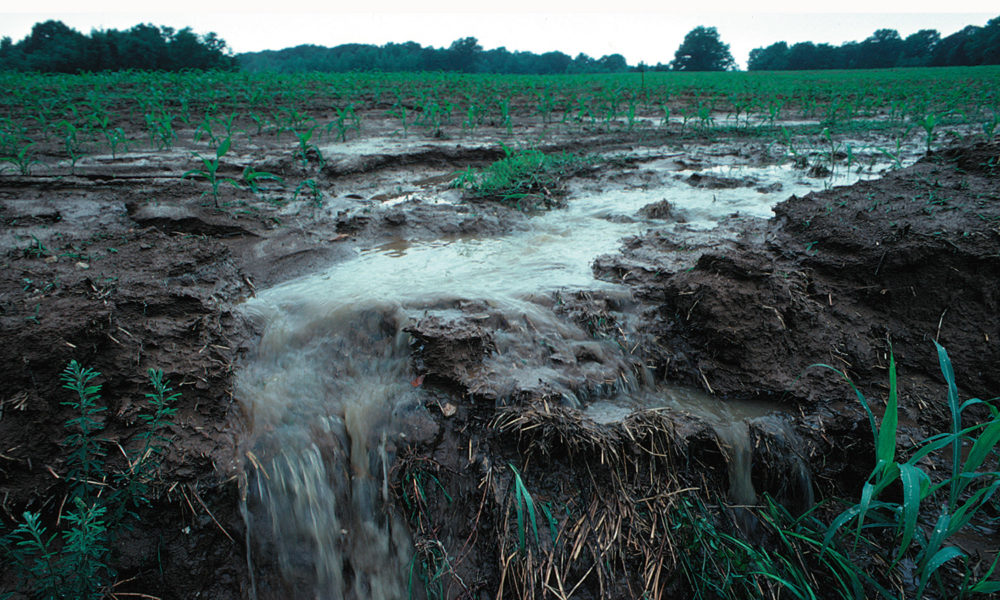Iowans have long prized their state’s deep, rich soils and its position as an agricultural powerhouse. In the heart of the Corn Belt, its farmers lead the nation in corn acres planted, and come in second in soybean acres. But there’s a dark side to all that: Decades of intensive, industrial-style production of those two crops—and little else—has decimated Iowa’s soil and fouled its waterways, leaving farmers and communities downstream and across the state vulnerable. Among the many issues state legislators are considering this month in Des Moines, soil health and water quality are arguably among the most urgent. And they need to act fast.
It’s not news to Iowans that they have a water quality problem. In recent years, report after report has documented the state’s rivers filling with nutrient runoff from farm fields, causing toxic algae blooms and drinking water contamination. Farming in the state is a major contributor to pollution beyond Iowa’s borders, driving the annual dead zone in the Gulf of Mexico, with costly impacts on fishing communities there. Sadly, the state’s contribution to that persistent problem has increased over the years: flows of nitrogen from the state running downriver to the Gulf grew by nearly 50 percent over two decades, according to a 2018 University of Iowa report, despite hundreds of millions of dollars spent to keep nutrients out of waterways. And earlier this year, a Union of Concerned Scientists report showed that if current trends continue, Iowa will spend between $41 and $333 million over the next five years for continued nitrate removal from drinking water.
And the problem is only likely to get worse as climate change advances, triggering more heavy rainfall events that scientists have shown to be a major driver of runoff from farm fields. Yet while the problem persists, year after year, researchers and farmers across Iowa have demonstrated that there are effective solutions. The all revolve around building the health of the soil.
Among these solutions are cover crops—crops planted between cash crops for the purpose of keeping soil protected from erosion, holding water and nutrients in the soil, and smothering weeds. The state of Iowa, in its Nutrient Reduction Strategy developed in 2013, recognized the power of cover crops to help solve the runoff problem. They set a goal of cover crop adoption on 60 percent of corn-soy acres. So how far has Iowa come since then?

As you can see, adoption of cover crops on Iowa’s farm fields did increase between 2012 and 2017 (the two years for which we have data from the USDA)…just not nearly fast enough. At this rate of growth, the state’s goal will take nearly a century to achieve.
By that time, Iowans will have paid far too much for cleanup, not to mention treatment of health problems associated with nitrates in drinking water. Moreover, the state’s farmers will have lost a whole lot of their soil. Erosion from wind and water annually robs our nation’s farms of billions of tons of soil, and nationwide, farms are currently losing twice as much topsoil to erosion per year as the Great Plains lost in a typical year at the height of the 1930s Dust Bowl. In Iowa, the problem is particularly concerning, with cropland in the state losing an estimated 5.5 tons of soil per acre per year. And climate change is likely to increase US erosion rates if we don’t act to slow them.
Iowa needs to do much more, much faster, to protect its soil and water. Action now to increase planting of cover crops (along with perennial prairie strips, agroforestry, and other healthy-soil practices) would hold farmers’ soil in place, keep nutrients out of Iowa’s waterways, store carbon, and—bonus—create spongier soils that can boost resilience to floods and droughts.
And with the Biden administration moving aggressively to address climate change, including promoting carbon sequestration in agriculture, Iowa can leverage federal policy changes and momentum with state healthy-soil action now.
So what should Iowa legislators do? Well, this week they are debating HF 646, a bill to improve management of the state’s soil and water resources. That bill should:
- Highlight the benefits of building soil health through practices such as cover crops;
- Fund programs that educate farmers, landowners and managers, and farm lenders about these practices and incentivize their adoption; and
- Create a state task force to develop and advance policy solutions for Iowa’s soil health and water quality issues.
WHAT YOU CAN DO: If you live in Iowa, you have a stake in its soil and water. Tell your legislators to act now to help the state’s farmers protect these essential resources. Click here to send an email to your legislators today!

